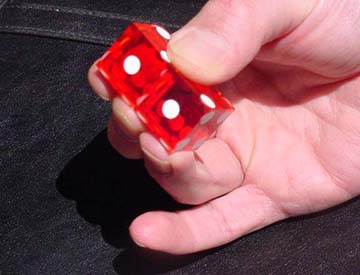The Grip:
This is a picture of my original grip, the 3 fingered front grip. Once I had the dice situated in the pre-set of my choice. I used my thumb on one side, and my first 3 fingers to grip the other side. This grip is a “deep” grip because the fingers are close to the table surface.

This grip served me well. But the more I practiced, the more I realized that surface friction sometimes caused inconsistency in my throw. I adjusted my grip by starting with the three-fingered front grip, securing the dice on the table surface (below)
(top view)

(bottom view)

At that point, I remove the first and third finger from the dice, and press them to the table surface:

When my hand is in the above position, I’m prepared to throw. The above position gives me a very stable starting point for my throw. Please note that the two fingers gripping the dice are perfectly aligned down the center of the dice.
Having taught myself to throw based on Yuri Kononenko’s Book I throw the dice from the table. I do not pick them up, prior to throwing. When I’m ready to begin my throw, I pick the spot where I want the dice to land and focus on it. Then, in a soft easy motion I move my arm forward and release the dice, opening my hand fully.
My arm movement is perpendicular to the back wall and I have a full follow through to about eye level. Despite having let go of the dice about one foot above the table surface. This grip and the follow through cause a natural slow backwards rotation of the dice, without having to flick my wrist.
Position:
My preference is to stand at one of the 2 positions to the immediate left or right of the stickman because it has one of the shortest shooting ranges on the table. No matter where I’m positioned, the dice will be set in a manner that they are parallel to the back wall, and my arm motion will be perpendicular.
If I get stuck in the straight-out position (table’s end) and am not having much success with this grip, I will frequently change to diagonal grip as I can impart more backspin on the dice using that grip. The diagonal grip is also quite a useful tool to battle really bouncy tables.
The Throw Itself:
I throw the dice at an angle ranging from 30 to 45 degrees (depending on table conditions) Once the dice leave my hand, they should be traveling together, rotating at the same speed, impacting the table at the same moment, and coming to rest at the same time. When you’re practicing, it’s fine to watch the dice while they travel through the air, to make sure they are behaving as you intend. BUT, once you have mastered your throwing mechanics, I urge you to refrain from this. Grip the dice, find your landing zone, and stay focused on the landing zone until the dice come to rest.
Ideally, I want the dice to travel together, strike the table together approximately 6 to 12 inches from the wall (depending on table conditions), and the second bounce of the dice should occur where the table surface meets wall. (there are no pyramid diamonds on the bottom portion of the back wall) You want to ensure the dice strike the wall on the flat portion. (not the curved portion or the side wall).
Stance:
I stand in a manner where my hips are always parallel to the back wall. So, if I’m stick right, I square my body toward the stickman. My left foot is slightly ahead of my body, my right foot slightly behind, and I lean against the table for added stability. (If I’m stick left, the foot positions are reversed). If I’m shooting from straight out, again I square myself to the back wall, and lean against the table for stability.
What To Avoid
- You do not want the dice to land on someone’s chips. This is difficult at a busy table. Find your landing zone BEFORE you toss! Remember, this requires concentration.
- If you toss the dice in such a manner that when they land, they hit each other, the dice will probably ricochet in different directions. This occurs most frequently when the dice don’t travel in a perfectly horizontal manner. Try to avoid this at all costs.
- Never shoot from the hook! It is very difficult to align your body, and throw correctly from this table position.
- You do not want to be fumbling with the dice. LEARN AND PRACTICE your preferred sets so that you can quickly be ready to toss again. The more quickly you get the dice situated, the more time you have to find your landing zone and concentrate on it.

